No. 14: One Year In
A brief toast, Seattle’s Mutual Fish, shellfish & history, and the new Hog Island cookbook
This last week of September marks one year since I began this newsletter. I’m opening a virtual little split of Champagne in honor of the occasion. Heck, make it a pink Champagne cocktail à la An Affair to Remember (one of my favorite films, which I worked into this travel-themed issue from April with a brief item about retro ocean liner dining).
I’d have hoped to get more than 14 issues sent out in this first year, but that’s how things went. I have dozens of newsletters’ worth of topics to cover and have hit a new groove of momentum to ensure sharing all those things with you more frequently and more consistently. (Maybe a bit shorter, too!) Goal number one for year two.

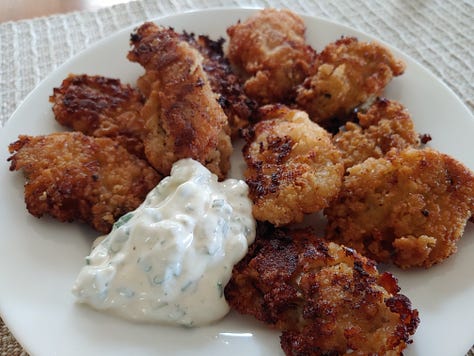
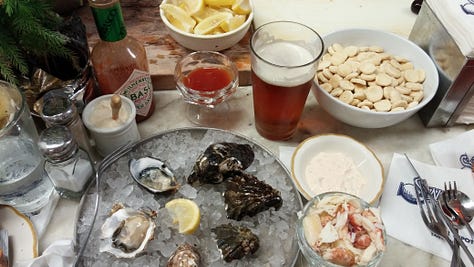
Part of what made the prospect of this newsletter interesting was the opportunity to discuss seafood from a wide range of perspectives—beyond the territory usually covered in the books and articles I’ve written for many years. It’s been a pleasure sharing topics such as fish leather, a visit to a gorgeous trout farm in Idaho, Simply Seafood reminiscences, and the simple pleasure of casual seafood conversations. And of course lots of notes from travels.
Last summer, before I jumped on board, I’d searched for other seafood-related Substacks to see what might already be in the mix. There were a handful of newsletters that referenced seafood in the name, but not exactly reflected in the content. The most seafood-focused I found was Popping Tins from a tinned-seafood enthusiast—a fun read, sharing explorations with a wide range of tinned products.
I just did the same search over a year later, and not much has changed. At least this newsletter now shows up at the top of the “seafood” search results on Substack! To help mark my first year, I’d be most grateful if you let some of the seafood fans in your life know about Seafood Savvy, using this convenient button below if you’d like. Thanks!
End of an Era: Seattle’s Mutual Fish
It was such surprising news early this month that Mutual Fish—Seattle’s venerable, extremely-loved seafood market—would be closing on September 16. There was instantaneous outpouring of love for Mutual as news got out, and especially for the Yoshimura family behind it. Dick Yoshimura opened the store with his brother over 75 years ago (at its current location since 1965). His son Harry worked at his side, with Harry’s son Kevin joining the family business in due time as well. Dick passed away in 2012, I was honored to write a tribute for Seattle magazine.
Harry was in his usual spot in the corner office when I paid my final visit to the store a couple days before their last. We chatted and reminisced for a while, other appreciative customers passing by to visit, sharing memories and good wishes with the family. One gentleman let Harry know that his father had been among those from the University of Washington fisheries department who helped Harry’s dad set up the live tank systems for the store back in the 1970s. To my knowledge, Mutual Fish was the first retail store in Seattle to have live tanks for oysters, crab, and other shellfish. That degree of commitment to quality is part of what made regulars out of so many in the area, chefs as well as home cooks. Way long ago in 2001 when I was food editor at Seattle magazine I wrote a piece about some stores where Seattleites could find the same ingredients chefs were putting on their menus. In that article I led off with Mutual Fish, noting that Tom Douglas sometimes listed “Harry Yoshimura’s Fish of the Day” on the Dahlia Lounge menu, so confident he was in whatever fish Harry recommended.
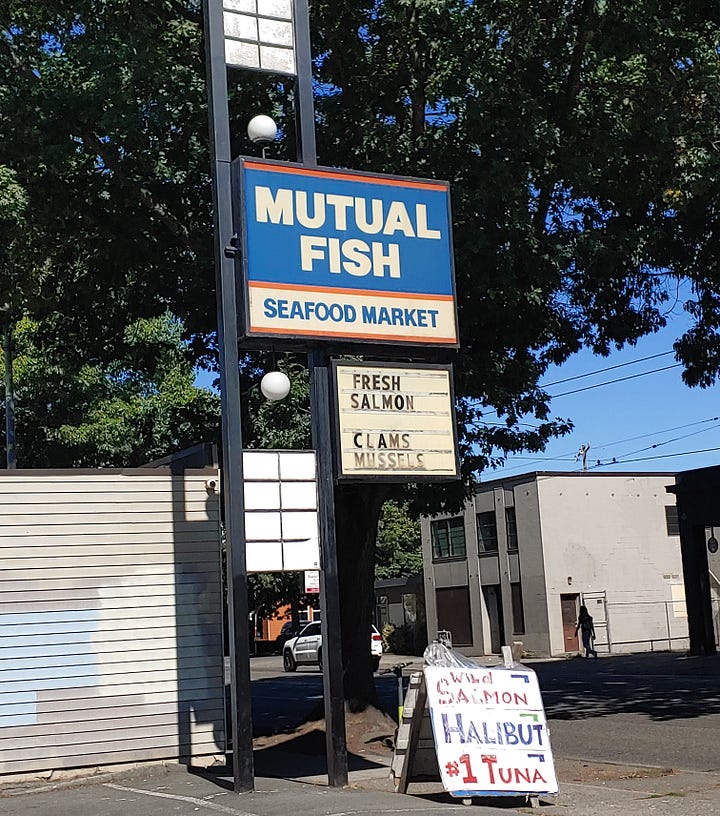
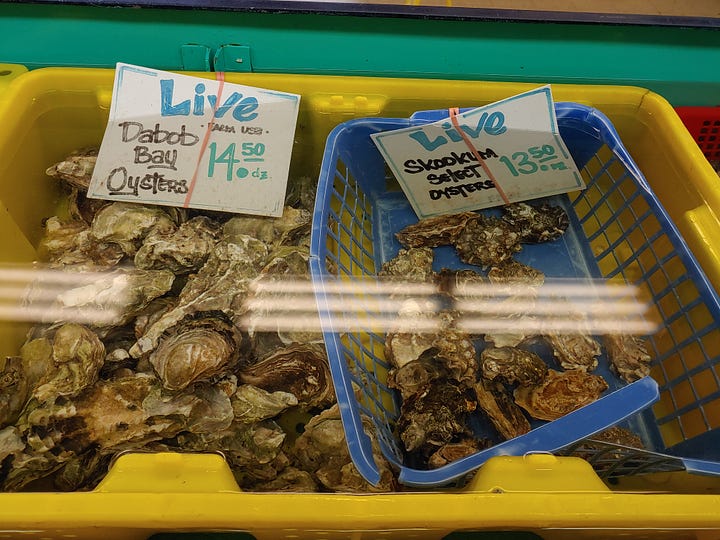
Seattle is losing a beloved resource we’ve counted on for decades. Based on posts and articles about the store as word of its closure spread, the impact of Mutual and the Yoshimuras will linger in countless ways for many years to come. That may be in the form of our heightened appreciation for choosing top-quality seafood to cook at home, or in the commitment to quality carried out by other area retailers (some of whom spent time working at Mutual), or by chefs who gained keen insights from the family about making the most of the best of whatever seafood is available any given day.
Those lessons certainly aren’t unique to Mutual Fish, though their closing puts a fine point on the extraordinary value of finding—and frequently visiting—a great seafood market you can trust. Nothing beats walking in the door and knowing you’re in good hands. And we do ourselves an extra favor of asking questions while there, learn a little something new—about a species, storage tips, cooking ideas—on each visit.
Out and About: Shellfish & History at MOHAI, Oysters in Maryland
I was thrilled to be asked to moderate a conversation with two authors who have taken deep dives into two of the most iconic seafoods of the Northwest. David George Gordon will share the story behind publication of Heaven on the Half Shell: the Story of the Oyster in the Pacific Northwest (originally in 2001, a second edition released this year), and David Berger will do the same for his book Razor Clams: Buried Treasure of the Pacific Northwest. I’ll be posing questions to them, looking forward to learning more about both of these delectable bivalves. They’ll be signing books after the talk, as well. If you’re in the Seattle area, consider joining us for “History on the Half Shell” at the Museum of History and Industry in South Lake Union Saturday September 30, 2:00 to 4:00. Attendance is free, more details available here.
On the festival front, I’m bummed to be missing the Shelton OysterFest, out of town for a conference. But I do plan to be at the U.S. Oyster Festival in St. Mary’s County Maryland for the first time! I’ve known of that festival dating back to when I attended the Shelton festival regularly years ago (judging the seafood cook-off there was one of my favorite events each year). Look for a recap of that Maryland visit in an upcoming issue. If you’ve got a favorite seafood festival you look forward to attending each year, let me know in the comments.
On the Shelf: The Hog Island Book of Fish & Seafood, by John Ash
Helping celebrate Hog Island Oyster Company’s 40th anniversary of oyster farming is this gorgeous book released earlier this year, written by the celebrated chef John Ash. John is among the array of folks I was lucky to meet and work with while editor of Simply Seafood magazine in the 1990s. At that time he was culinary director at Fetzer Winery, we met at the winery’s 5-acre organic garden while I was in the area doing research for an article about Napa and Sonoma valleys, and he wrote some tips for pairing wine with seafood for that piece.
Our paths have crossed occasionally in the years since, including a couple times I was a guest on the Good Food Hour radio show he co-hosts with Steve Garner. I so enjoyed the opportunity to talk with him earlier this month about his new book.
The Hog Island Book of Fish & Seafood is a substantial volume, definitely one to consider adding to your collection. A handful of the things that I’ve appreciated in the content so far:
There’s a good overview of what they acknowledge to be the “vast, controversial, and complicated topic” of sustainable seafood (which I have barely touched on here for the same reason; goal number two for year two: more on sustainability), including the four steps of Hog Island’s approach to sourcing sustainable seafood.
I love the various notes throughout that recommend asking questions of your fishmonger when shopping, such as whether the scallops are dry-pack (i.e. not treated with additives) and about the sustainability of any particular seafood in the case. I’m a BIG fan of this: when customers engage with retailers, they not only to get their questions answered (hopefully), but also these questions indicate to retailers what customers care about. Such valuable interaction!
The 250-plus recipes cover a few dozen types of fish and shellfish, plus tinned seafood, roe, seaweed, and other foods from the sea. Beyond the recipes that John created based on his experience and inspirations, there are also recipes from chefs at Hog Island restaurants, as well as from a handful of other chefs who “have embraced the Hog Island sustainability ethic” as noted in the book’s introduction. It makes for a good range of styles and flavors to suit any number of occasions and preferences. In our conversation, John mentioned that black cod (sablefish) is among his favorite fish, noting it’s nearly impossible to overcook. The buttery, rich fish has five recipes in the book, the Sablefish Coconut Curry with Vermicelli looks particularly enticing.
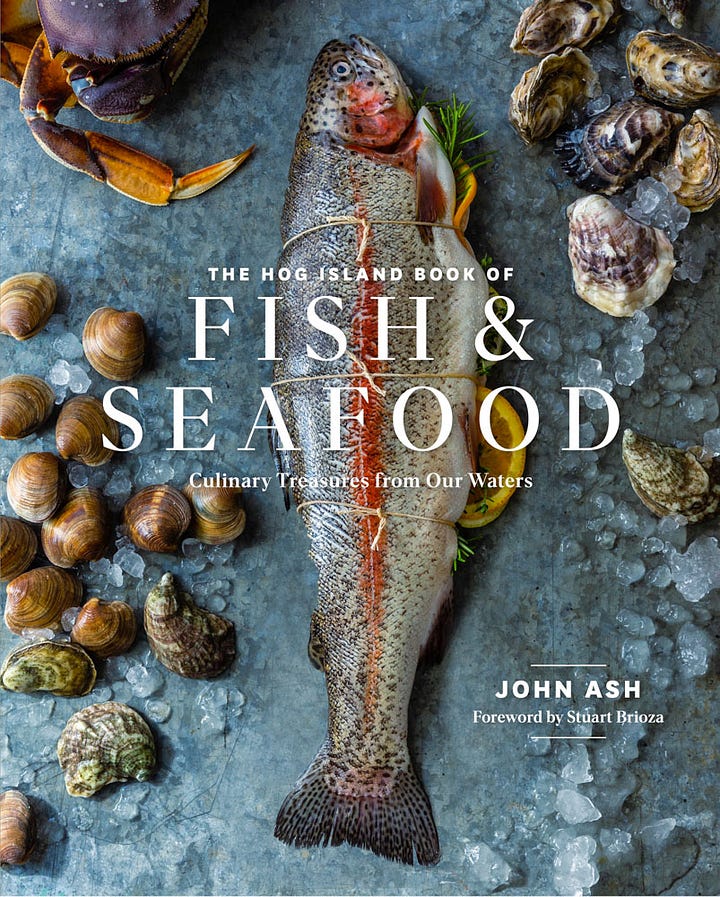

The first recipe I made was the Wine Country Gazpacho with Shrimp, taking advantage of ideal timing for late-summer tomatoes from the farmers market. It was a perfect example of the value of following my own advice: save shells (crab, shrimp, lobster) and use them to make a batch of shellfish stock to tuck in the freezer. I was grateful to have one such bag on hand for the couple cups called for in this recipe, adding light seafood character to the flavorful soup.
Next up, and the recipe I include below, was Herbed Cast-Iron Squid—in part because the photo, with it generous complement of herb dressing spooned over the squid, simply looked so delicious. And because of how very seldom I cook squid at home. I couldn’t say when the last time was, in fact. It was time for me to catch up a bit with squid and remind myself to work it into my home-cooking repertoire more often (there are another half-dozen options in this book, for starters).
My neighborhood grocery store has cleaned squid available frozen in a one-pound pack, plus packages of smaller quantities thawed in the seafood section. I used the latter for this recipe, and now have the former in my freezer ready for a quick thaw for next time.
In John’s introduction to this recipe he says, “This pan-seared squid topped with a fresh-herb dressing is my version of a simple and delicious dish served by chef B Adamo, head chef at the Hog Island Oyster Bar in Larkspur.”
Herbed Cast-Iron Squid
(from The Hog Island Book of Fish and Seafood, by John Ash)
Herb Dressing
1/2 cup (120 ml) olive oil
1/2 cup (25 g) finely chopped fresh flat-leaf parsley
1/3 cup (15 g) finely chopped fresh cilantro leaves and tender stems
1/4 cup (60 ml) fresh lime juice
2 teaspoons minced garlic
2 teaspoons kosher salt
1 teaspoon finely chopped serrano chile
1/4 teaspoon ground cumin
Seared Squid
1 pound (455 g) cleaned squid
Olive oil
Kosher salt
Cilantro sprigs, for garnish
Flaky sea salt, such as Maldon, for garnish
Lime wedges, for garnish
To make the dressing, combine the olive oil, parsley, cilantro, lime juice, garlic, salt, chile, and cumin in a small bowl and stir lightly to blend. Set side.
To make the squid, cut the squid tubes into 1/2-inch rings and cut the tentacles in half lengthwise. In a large cast-iron pan, add enough oil to cover the bottom of the pan, and heat over high heat until it shimmers. Working in batches if necessary to avoid crowding the pan, lightly salt the squid, add it to the pan, and sear until the edges are slightly crispy and charred, about 2 minutes.
In a medium bowl, combine the squid and the dressing; toss to coat. Serve at once, garnished with cilantro sprigs and flaky salt, with lime wedges alongside.
Serves 2 to 4




